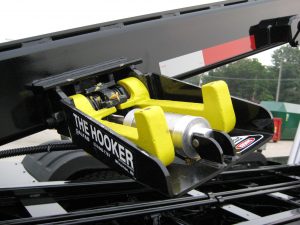
Heavy Duty Extendable Tail Hoist
- Heavier Duty 10” mainframe with no subframe making it capable of handling heavier loads
- Low loading angle without losing your 48 degree dump angle
- Great for scrap applications
- Inside controls standard reducing the chance of driver injury
- Durable rear hinge designed to withstand the stress of grueling day after day use
Heavy Duty Extendible Tail Hoist
Our Advantage
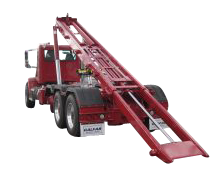
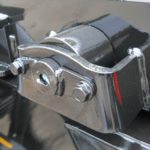
Outboard Supported Side Rollers
Greasable roller shaft is removable with two bolts.
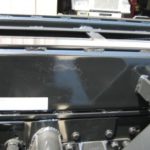
Wear Strips
Strips on top and bottom of the mainframe help prevent wear and reduce friction.
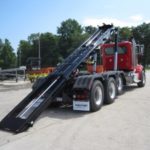
Lowest Loading Angle
Low loading angle is great for areas with low overhead and loading containers with lose debris.
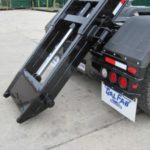
80” Extendible Tail
Extendible tail gives your container added support while not losing your 48 degree dump angle.
Standard Features
- 10 x 4” Tube Main Frame
- 2 1/2” Diameter Rear Hinge
- All Working Points Greasable
- 1” Spring Loaded Container Locks
- 2 1/2” Diameter Lift Cylinder Shafts
- 10” Diameter Vertical Front Sheave
- 10” Diameter Horizontal Sheaves
- 10” Diameter Sheave Blocks
- 52 Gallon Oil Reservoir
- Suction Screen and Return Filter
- Inside and Outside Controls
- Sealed Lighting System
Options
- “The Hooker” Hold On Systems
- Behind Cab and Oversize Oil Tanks
- Tool Boxes
- Auxiliary Stops
- Poly or Steel Fenders
- Tarping Systems
- Ratchet Tie Down Straps
- Pintle Hook
- Front Mount Pump
- PTO
- Drop Shaft
For the Ultimate in Container Securement, add “The Hooker” to your Roll Off Hoist.
The Heavy Duty Extendable Tail Hoist can be paired with these Chassis and Containers
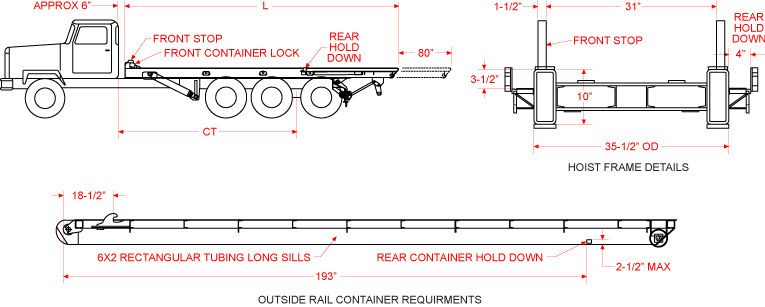
Product Specifications
* Cycle Times are Factory developed and controlled by PTO output, oil viscosity, human and mechanical efficiency, and may vary accordingly. All dimensions are subject to steel and manufacturing tolerances.
Videos
Rollers are bolted to the side of the frame, allowing for easier replacement and better support of the container.
Literature

| Stock Number: | 13451N |
| Type: | Roll Off |
| Manufacturer: | Western Star |
| Model: | 49X |
| Exterior Color: | White |
| Engine Manufacturer: | Detroit |
| Engine Type: | DD13 |
| Transmission: | Allison 4500RDS |

| Stock Number: | 13859N |
| Type: | Roll Off |
| Manufacturer: | Western Star |
| Model: | 49X |
| Exterior Color: | White |
| Engine Manufacturer: | Detroit |
| Engine Type: | DD13 |
| Transmission: | Allison 4500RDS |

| Stock Number: | 14235N |
| Type: | Roll Off |
| Manufacturer: | Western Star |
| Model: | 49X |
| Exterior Color: | White |
| Engine Manufacturer: | Detroit |
| Engine Type: | DD13 |
| Transmission: | Allison 4500RDS |

| Stock Number: | 14071N |
| Type: | Roll Off |
| Manufacturer: | Freightliner |
| Model: | M2 106 |
| Exterior Color: | White |
| Engine Manufacturer: | Detroit |
| Engine Type: | DD8 |
| Transmission: | Allison 3500RDS |

| Stock Number: | 14454N |
| Type: | Roll Off |
| Manufacturer: | Peterbilt |
| Model: | 567 |
| Exterior Color: | White |
| Engine Manufacturer: | Cummins |
| Engine Type: | X-15 |
| Transmission: | Allison 4500RDS |

| Stock Number: | 14421U |
| Type: | Roll Off |
| Mileage: | 178,776 |
| Manufacturer: | Peterbilt |
| Model: | 567 |
| Exterior Color: | White |
| Engine Manufacturer: | Paccar |
| Engine Type: | MX-13 |
| Transmission: | Allison 4500RDS-P |

| Stock Number: | 13784N |
| Type: | Roll Off |
| Manufacturer: | Western Star |
| Model: | 49X |
| Exterior Color: | White |
| Engine Manufacturer: | Detroit |
| Engine Type: | DD13 |
| Transmission: | Allison 4500RDS |

| Stock Number: | 14422N |
| Type: | Roll Off |
| Manufacturer: | Western Star |
| Model: | 49X |
| Exterior Color: | White |
| Engine Manufacturer: | Detroit |
| Engine Type: | DD13 |
| Transmission: | Detroit |
